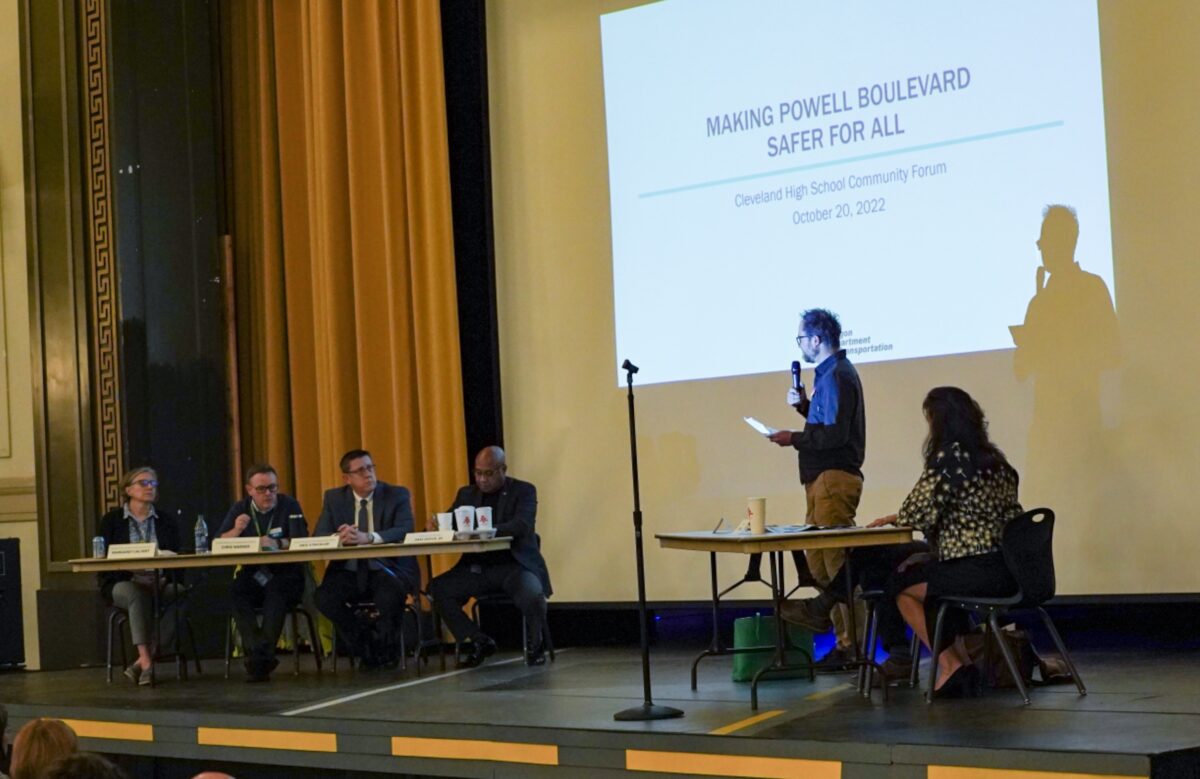
Well over 200 people who showed up for a community forum to discuss street safety issues at Cleveland High School Thursday night.
Just 16 days after Sarah Pliner was hit and killed while bicycling across SE Powell Boulevard and 26th Avenue, the leaders of the Oregon Department of Transportation, Portland Bureau of Transportation, TriMet and a raft elected officials and top agency staff endured a two-and-a-half hour event where everyone was able to speak their mind, air concerns, and have direct access to key decision makers.
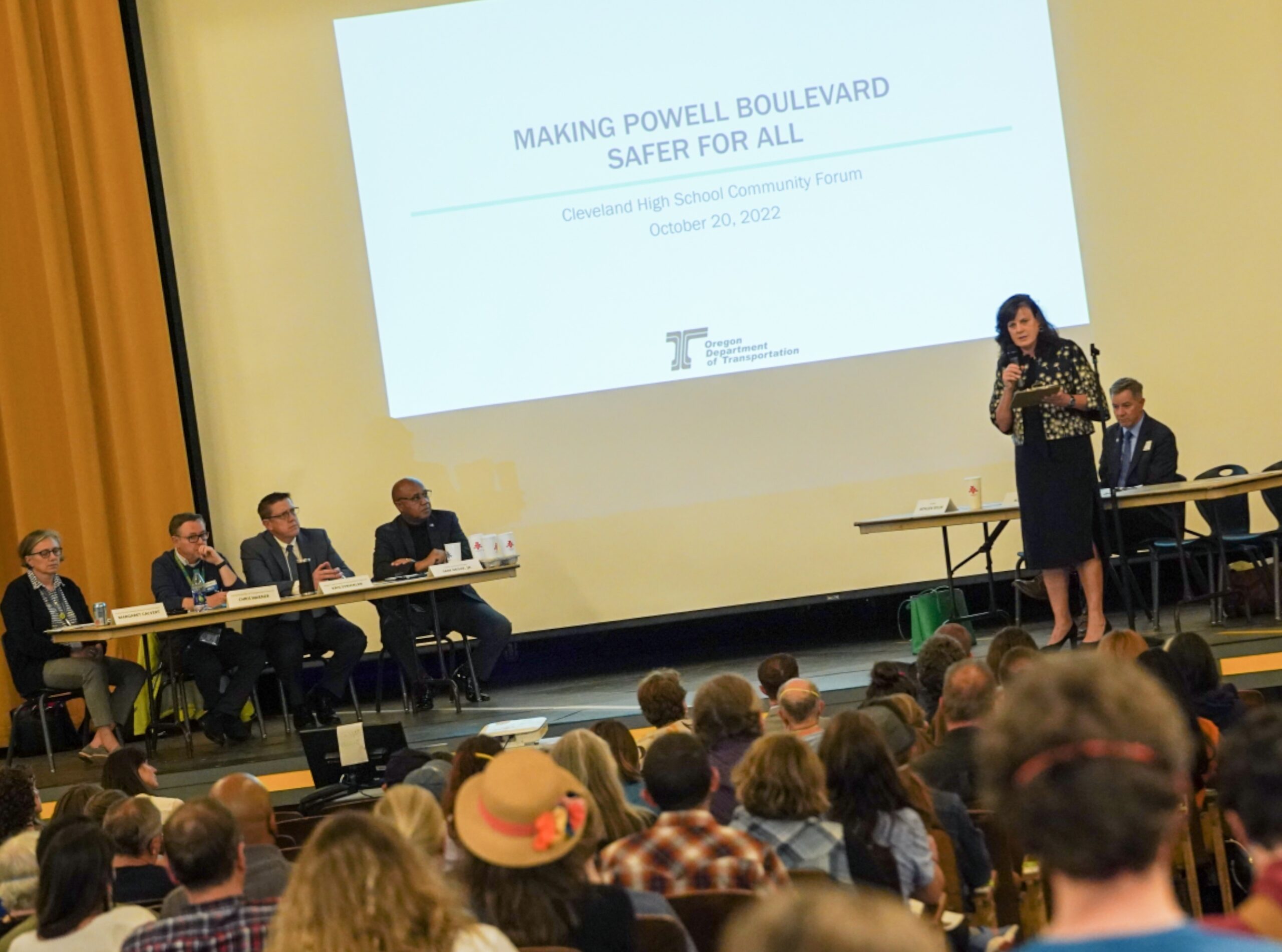
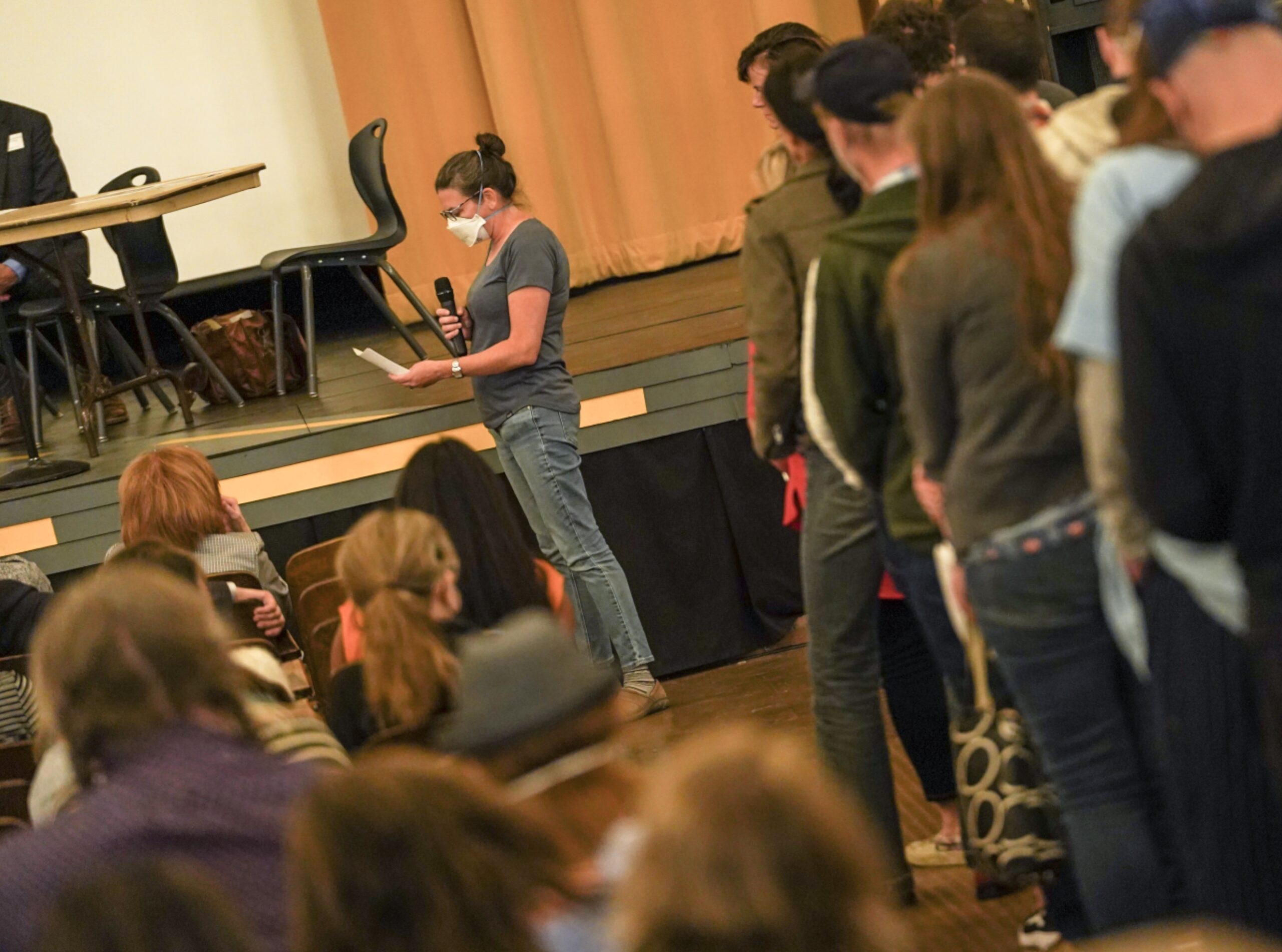
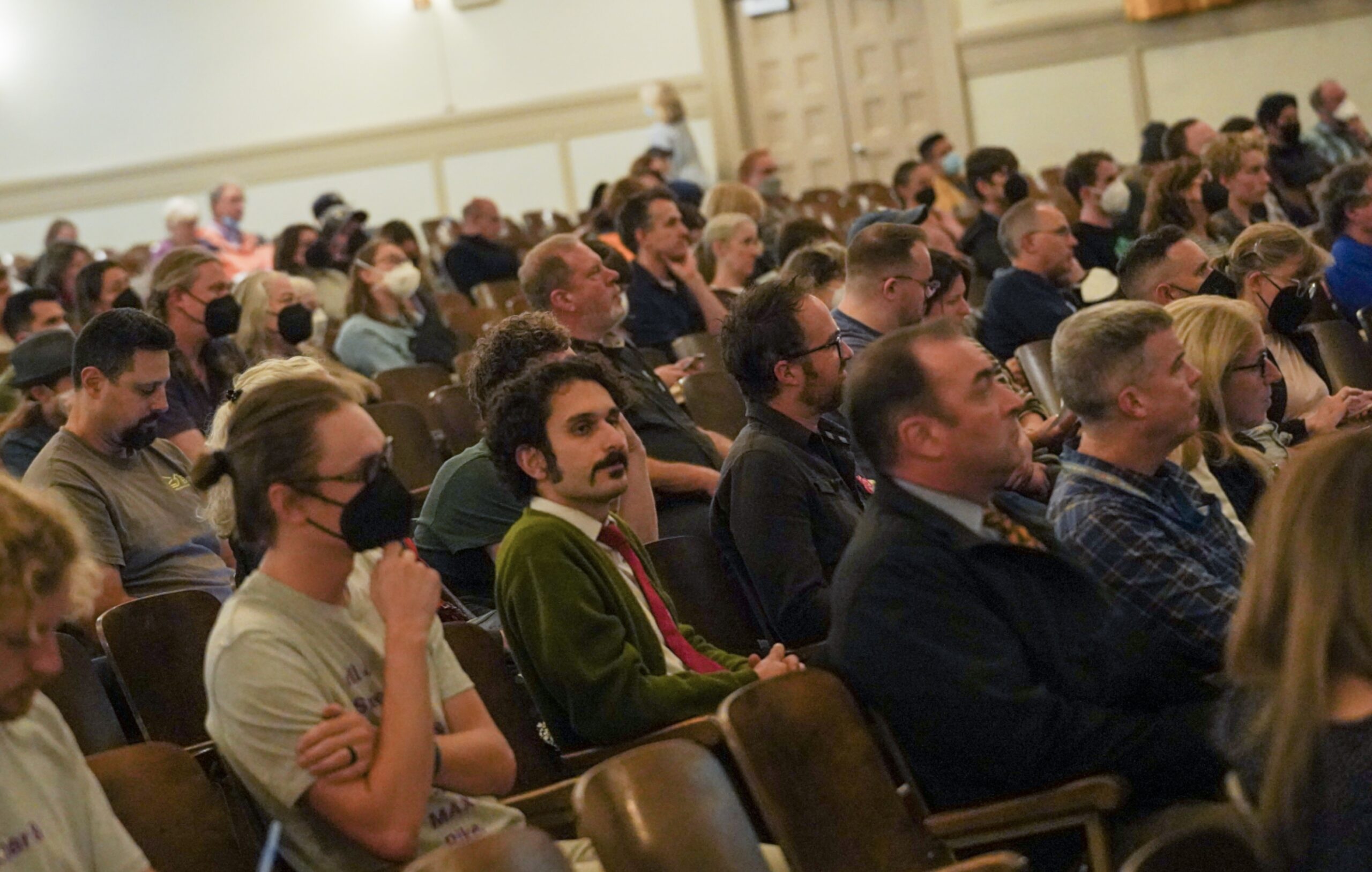

Oregon State Senator Kathleen Taylor, who represents the district and whose daughter is a senior at the school (she also had a son who graduated three years ago), hosted the event. The fact that she was able to pull such an impressive gathering together on short notice might have had something do with Oregon Governor Kate Brown. After holding a moment of silence for Sarah Pliner, Senator Taylor shared in her opening remarks that just days after the tragedy, she got a phone call from the Governor: “She said, ‘Senator Taylor, I’m here for you and I am here for southeast. Let me know whatever I can do to be helpful,'” Taylor recounted.
While it was nice of the Governor to engage on this high profile fatality, folks in the crowd were much more interested in the two people sitting on the stage: ODOT Director Kris Strickler and PBOT Director Chris Warner. As we’ve reported, it appears that so far these two and their respective staffs have been working closely together for the past two-plus weeks. Last night’s crowd was peppered with high-level staff from both agencies (many of them feverishly scribbling notes as people spoke), a sign that they are taking the community’s concerns about SE 26th and Powell seriously. (I also noticed that both agencies brought government affairs staffers along — PBOT Intergovernmental Resources and Policy Affairs Manager Shoshana Cohen and ODOT Government Relations Assistant Director Lindsay Baker. PBOT Commissioner Jo Ann Hardesty was also in attendance. She sat in the crowd and never sought the mic.)
The fact that leaders from PBOT and ODOT conspired just a few years ago on an intentional plan to make the intersection where Sarah Pliner died less safe for cycling, might have something to do with the actions, tone and urgency we see from them today.
Before he walked on stage, I asked Director Strickler why he’s been so willing to engage and respond to this incident. “We have so many needs in our state. Needs like this need to take priority,” he said. “We know we have incidents and we’re getting better addressing them, but it doesn’t mean we’re done. When you see things like this occur, we think we can do something more. It really is that simple.”
So far, that “something more” includes a lower speed limit and more paint striping in the intersection (more on planned changes below). I asked Strickler if he’s willing to consider a road diet on Powell. “One can say ‘reduce the lanes,’ and there’s a big part of me that’s all for reducing the lanes out here even [waving to Powell Blvd]. The problem with that is there are consequential outcomes associated with that for neighborhoods and other things so it’s not something we can do tomorrow morning. We need to have a conversation about what the impacts are. We don’t want to make it worse in other areas and create other safety issues.”
If Strickler needed to be refocused on the impacts and safety issues we face every single day on SE Powell and 26th because of those lanes, a powerful speech from Bike Loud PDX Chair Kiel Johnson likely did the trick. Sen. Taylor gave Johnson the mic to speak “for the bicycling community” before Strickler and Warner gave presentations about their project plans.
Johnson took full advantage of the moment. Standing just feet from Strickler and Warner, he said directly to them:
“Sarah Pliner’s death was not an accident. It was the result of a series of decisions transportation leaders have made. In 2018, we stood at that very intersection to protest the removal of the green painted bike boxes. We stood there because we knew those green bike boxes made us safer. Why would anybody remove those bike boxes?!
If you go up and down Powell, you’ll see no pedestrian crossing signs, as well as places where there used to be ‘No Crossing’ signs until drivers ran them over.
That’s the approach ODOT has taken on Powell for decades, as well as with there other urban highways — to design the roads only for the capacity and speed of private automobiles. And to manage safety for people outside of cars by telling them to go somewhere else.
Sarah paid the price for that approach. It doesn’t work.”
So. What are ODOT and PBOT going to do differently?
The plans
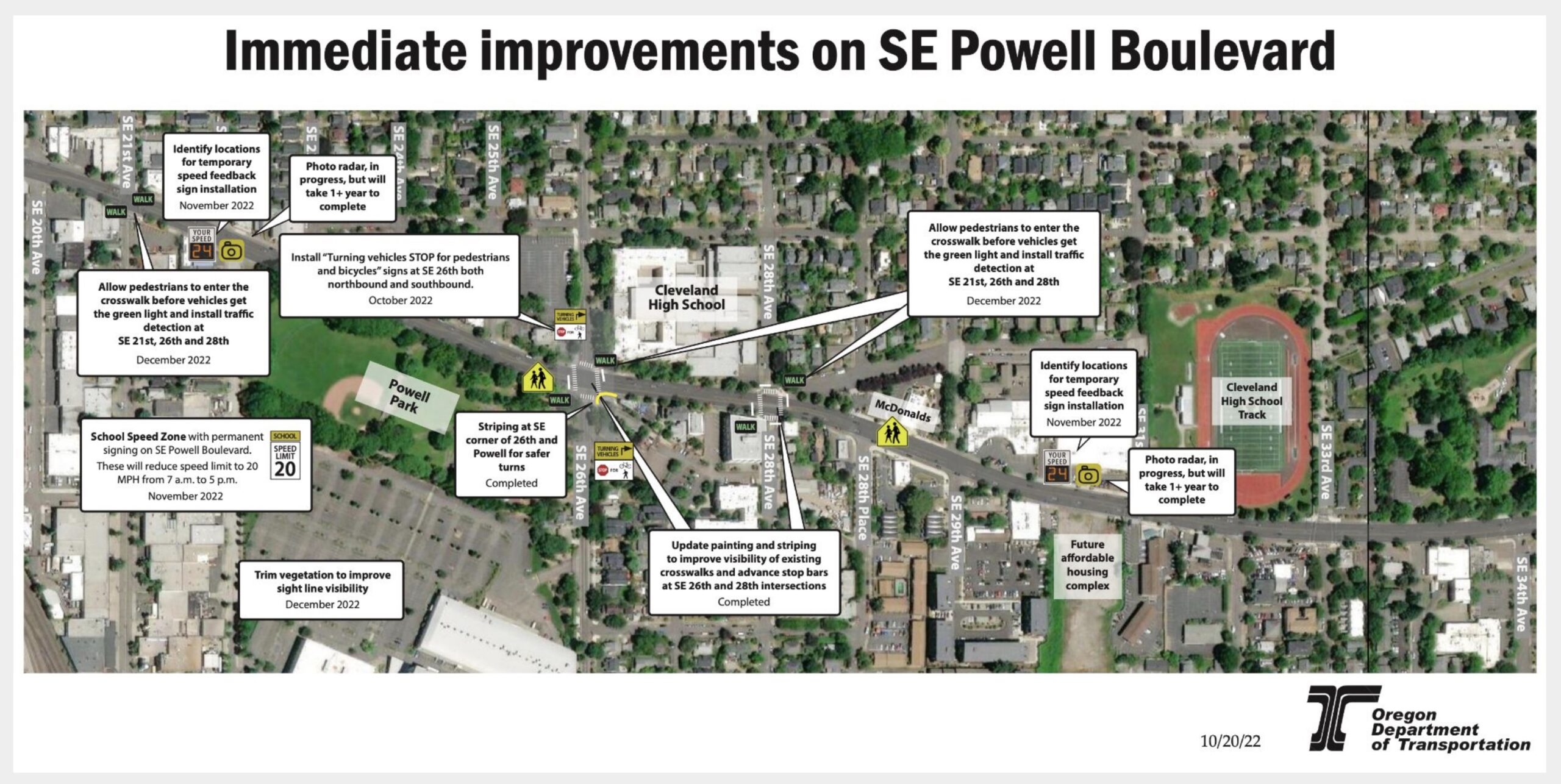

We reported some of that’s in store Thursday morning. Last night we heard a lot more.
The big news last night is that ODOT will follow PBOT and install a school speed zone on Powell Blvd. That’s a big deal since Powell is a state highway and the school zone will drop the existing 30 mph speed limit to 20 mph. The resolution created by PBOT Commissioner Jo Ann Hardesty and passed by council Wednesday called on ODOT to establish these school zones statewide wherever a school abuts a state highway. Strickler wasn’t ready to commit to that last night.
The other bit of news last night was that ODOT confirmed they will allow PBOT to install a leading pedestrian interval on the signal for northbound 26th Avenue at Powell. LPIs are proven safety measures that give crosswalk users a green several seconds before other road users.
Of course none of this matters without enforcement. To address that ODOT said they’ll install speed reader boards next month and they’ll follow-up with speed photo radar cameras on Powell east and west of 26th. But there’s a catch: Strickler said equipment delays mean they likely won’t deliver enforcement cameras for over a year. He said something about the pandemic playing a role, but it’s not clear why it takes so long (We’ll follow up on that to find out why.)

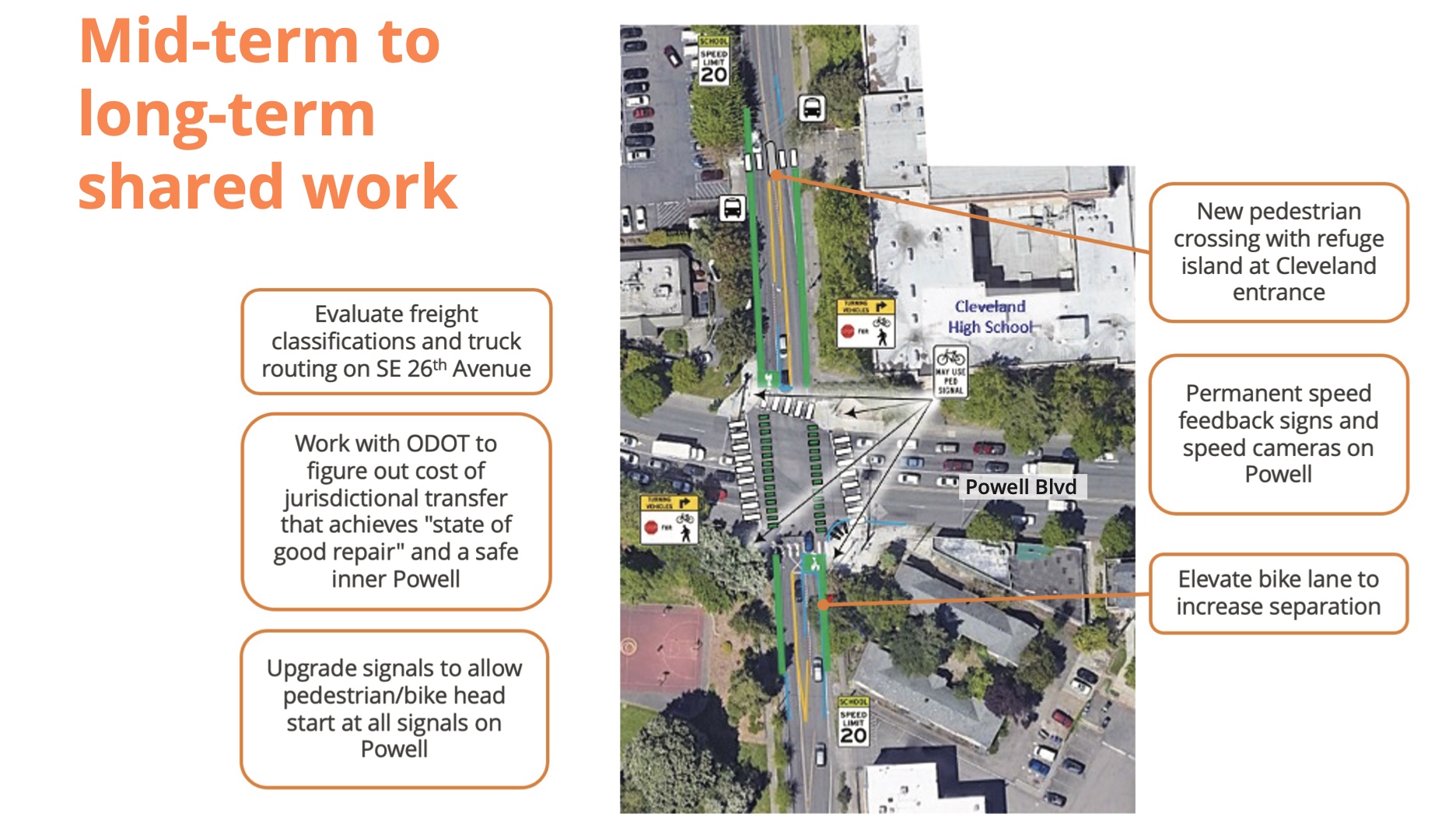
On the PBOT side of things, they plan to stripe green “cross-bike” markings in the intersection to help accentuate the green bike lanes and bike boxes they plan to reinstall soon. In the mid-to-long term, Director Warner said they’ll consider elevating the northbound bike lane, “to increase separation.”
TriMet is an active partner in all this too. General Manager Sam Desue, Jr. was on stage last night and he had a staffer present potential bus route changes aimed and reducing the amount of times students would need to cross Powell to get to school (below).
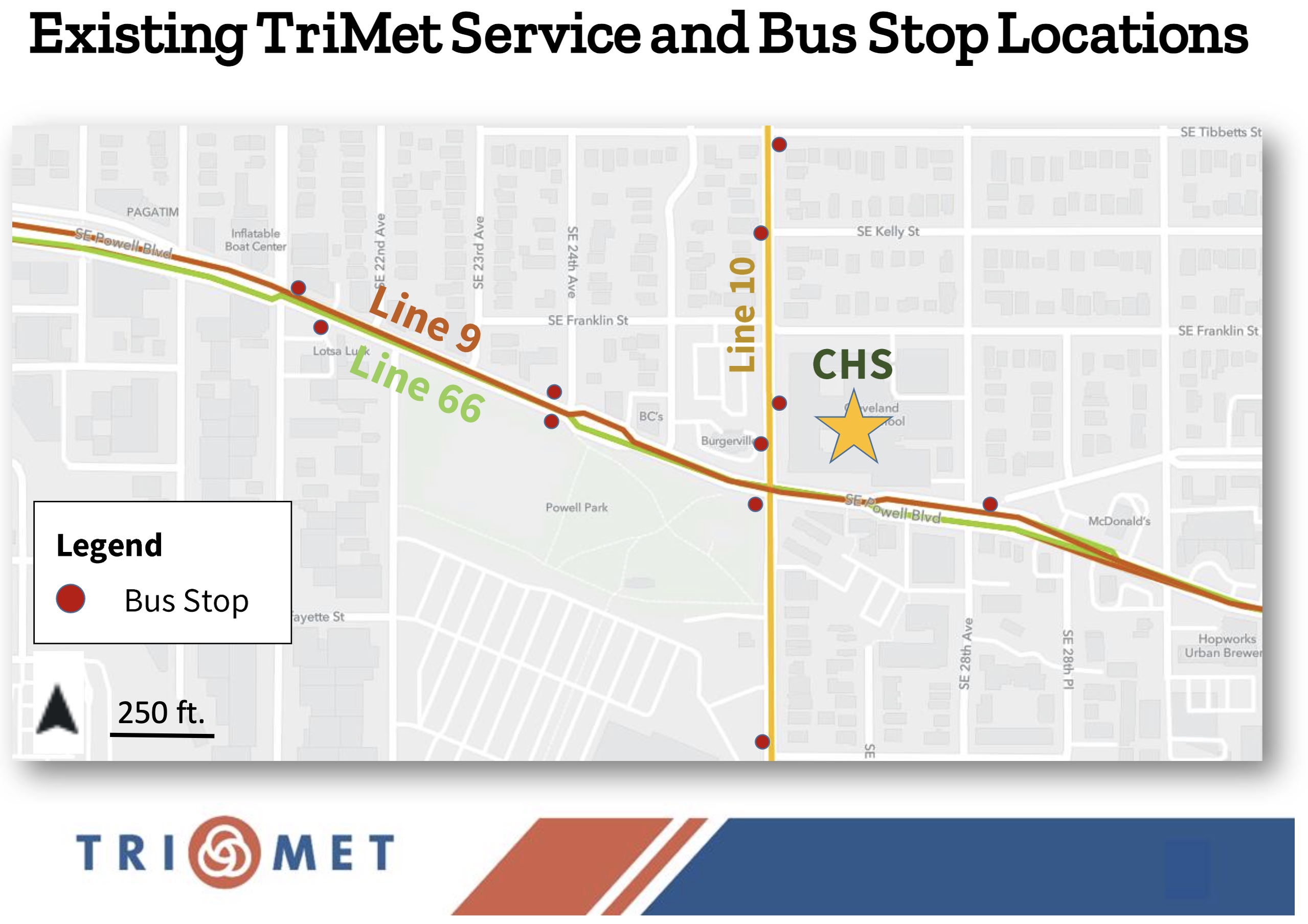
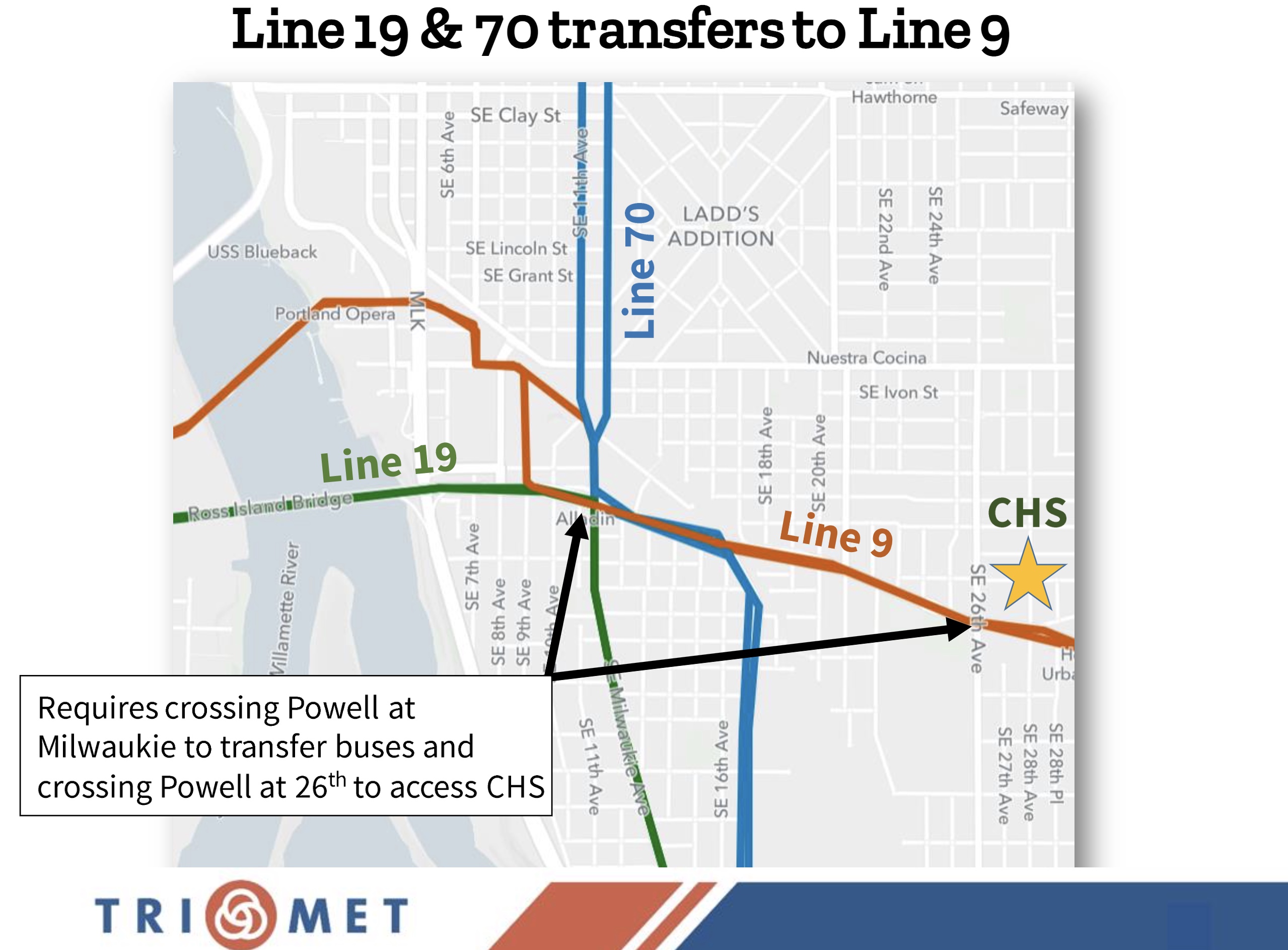

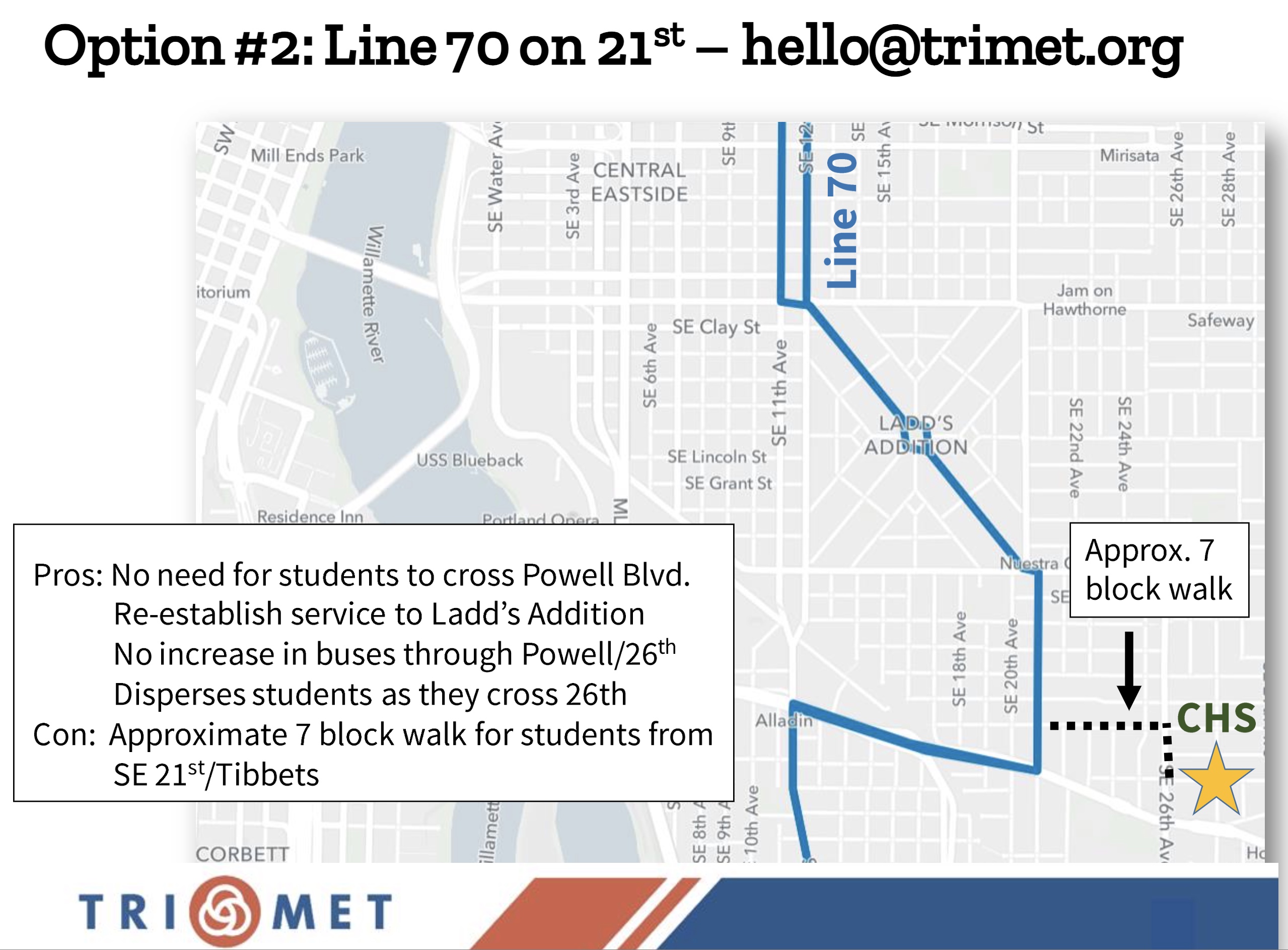
If the statements and plans from agencies aren’t enough to convince you folks are taking these issues seriously, how about the fact that Director Strickler said ODOT and PBOT have launched a task force to analyze not just Powell Blvd, but many other danger hot-spots throughout the region? There’s also a parent-teacher conference next week at Cleveland High where TriMet will flesh out their bus reroute ideas.
The Q & A

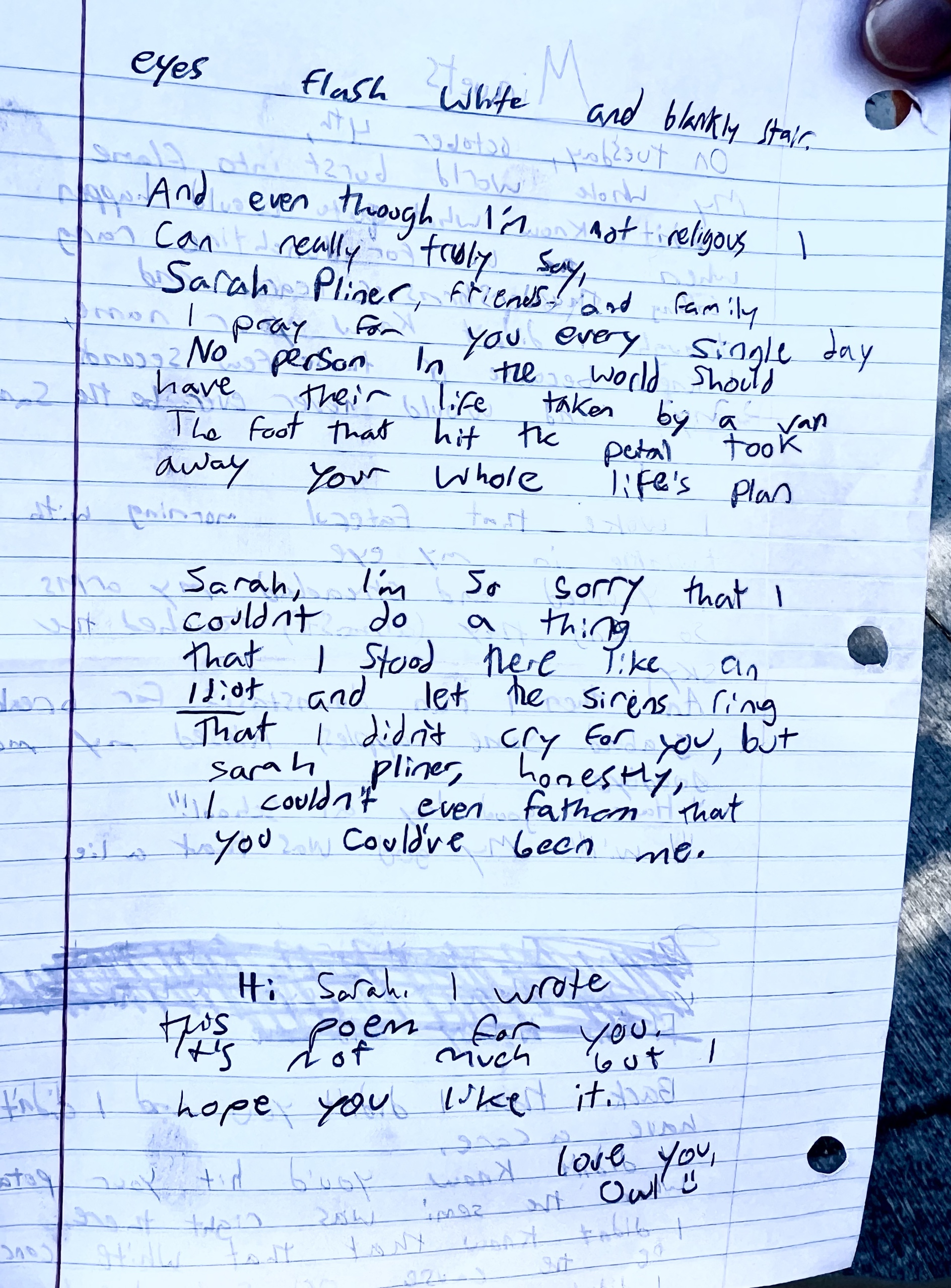
The second half of the event was all about the people who came to voice their concerns and pose questions. Dozens of people lined up and both ODOT Director Strickler and PBOT Director Warner got an earful.
The trauma felt by students, staff, and parents at Cleveland High was one of the most important things shared last night
A 14-year-old Cleveland student named Owl Brooke (who posted the poem pictured above at Sarah Pliner’s memorial) stunned many in the crowd. “I saw what happened. And it was just horrifying,” they said, gripping the mic tightly with both hands as they spoke. “And now there’s something that I have to go through in my life. And I’ve seen death. And some adults haven’t seen death. And it’s just, it’s just crazy. And I just wanted to say that like, something needs to change, something needs to happen here.”
A mom of a freshman at Cleveland named Susan stood up and described what happened right after Pliner was hit and her body was still in the road. Dozens of students where at Powell Park and had to walk across the intersection to get back to class. “A teacher held my daughter’s hand and guided her so she didn’t have to open her eyes again,” Susan said.
Kiel Johnson from Bike Loud asked Director Strickler about the possibility of a road diet on Powell. Strickler said reducing the number of lanes is something they “intend to analyze” in the upcoming weeks; but he also shared major caveats. “Now I will tell you the impacts of 40,000 vehicles that travel this facility,” he replied. “reducing the number of lanes and where they go, is something that we have to analyze very seriously, because the current street grid may not be able to handle it — and likely can’t — and so we have to analyze that with the city. But as I mentioned, all things are on the table. And we’ve asked our teams collectively to look at it with that in mind.”
Johnson also got Strickler to commit to adhering to ODOT’s Blueprint for Urban Design, a guidebook adopted in 2019 that requires engineers to use much more progressive facility designs that we usually see on state-owned roads.
Portlander Emily Guise wasn’t satisfied with Strickler’s answers on a potential Powell Blvd road diet. “I’ve heard a lot of talk about managing traffic, but I haven’t heard a lot of talk about how you will reduce traffic on Powell,” she said. “Just because there are 40,000 cars today doesn’t mean there needs to be 40,000 cars in the future.”
Next steps
These past few weeks have given us plenty of fodder for follow-up and have opened up important discussions about how to tame ODOT’s urban arterials. Coming so soon after the tragedies on 82nd Avenue last year, with traffic culture seeming to get worse with each passing day, and with a renewed sense of urgency for change, there is real possibility that this time we will see substantive shifts in how ODOT and PBOT approach these issues.
But with every passing day that Sarah’s death fades from the news cycle, so too might people’s interest in doing something to prevent the next one. I’ve seen it happen many times. And agencies know this. They know they won’t hear from people about any of this in a week or so. And that will tell them it’s OK to push this down their long list of “top priorities.”
If we want to change the streets, we have to change the system at its highest levels. We cannot let them forget Sarah Pliner. And Ashlee McGill. And Martin Crommie. And the dozens more dead people who’ve been sacrificed at the altar of automobility.
Last night, Portland activist Hami Ramani held up a piece of paper with the word “Love” typed on it. Then he yelled into the mic:
“When you’re out there walking, biking, taking transit, driving even — do you feel love on our streets? Is there love on our streets? It’s a simple question. I think it’s a resounding no. There is no love on the streets. I am so sick of the street-by-street. Are we really talking about bike boxes? Have you seen the pollution? We’re talking about bike boxes. So, do you feel love on the streets?”
Maybe “feel love on the streets” is a better goal than “vision zero.”
Stay tuned.


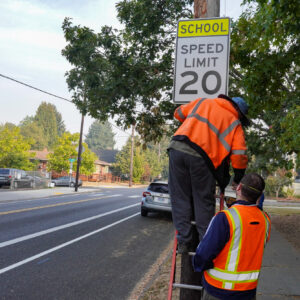
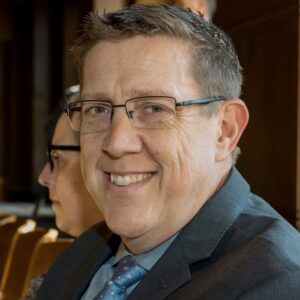

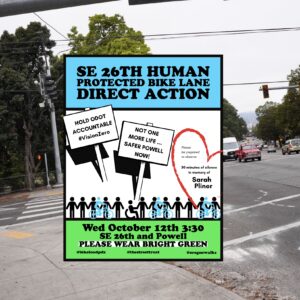
Thanks for reading.
BikePortland has served this community with independent community journalism since 2005. We rely on subscriptions from readers like you to survive. Your financial support is vital in keeping this valuable resource alive and well.
Please subscribe today to strengthen and expand our work.
It is horrible that so many young people had to learn directly that violent death is built into our transportation system.
It’s worse for the victims.
Yes. I agree that it is horrible. As a father of a ten year old, I feel constantly that I am in a balancing act of being real in terms of sharing information about our messed up transportation system (and our democracy, and the threat of climate change, etc.) is, while at the same time trying to not overwhelm them.
The mask that everything is ok with our transportation system – (ie the ODOT lies that moving cars quickly is the most important thing for our economy, or that more lanes are needed for the I-5 bridge) needs to be ripped off.
I empathize with the kids and adults who had to witness this.
More radical change is definitely needed. and I’m certain that’s not coming from C. Drazan, B. Johnson, R. Gonzales and their ilk.
It was a surprisingly good meeting. ODOT struck a much different tone than they have in the past (though they are still waging their #warontrees). That was encouraging.
As always, actions speak louder, so I’ll reserve final judgement until I see results.
I really hope they seriously consider adding a transit-only lane in both directions.
The proposed changes to line 70 seem bizarre to me. What proportion of riders on that line are Cleveland students? How many students would that change serve? Is it worth it to divert the bus ~15 blocks east?
No kidding; it would especially suck for the non-students who use that line to access jobs in the southern reaches of the CEIC (or who would have their ride to other places significantly extended).
And, as one person pointed out, it’s bad policy to route buses along greenways.
An additional reason for the change to line 70 is to avoid the Union Pacific train crossing on 11th where buses regularly get stuck. Even if the detour makes the bus takes longer on average, I’d love to see it for the improved reliability. If transit isn’t reliable, nobody can use it for purposes like commuting.
The #70 should be permanently rerouted over the MLK viaduct (using the route the FX uses when the crossing is blocked); that would add 2-3 minutes to the journey, but would hit most of the current stops and make the route much more predictable.
I’d absolutely support that change too. Anything to get it off its current route there.
I actually like the Powell to 21st Ave route proposal. It’s way less of a deviation than what is shown in the Forward Together Plan, and it better serves the High School for students in Sellwood.
Move the train yard or spend a lot of money to eliminate the at-grade crossing at SE 11th and 12th. Those are essentially the two choices. Moving the train yard would also eliminate the trucks on SE 26th and probably require the RR to pay, so that would get my vote; the grade elimination would be a poor second choice requiring public funds but may need to be done eventually either way.
I anecdotally see plenty of CHS students waiting at the 17th and Rhine stop for the 70 after school, so I think it does get fairly significant ridership from the school. But it’s so so much more than a school bus – it’s the only N/S bus that crosses Powell between the river and Cesar Chavez without heading downtown and is a critical link for me personally in getting around Portland (especially to go places North/Northeast like the airport).
I don’t entirely see why the changes are needed for a hypothetical 9 to 19/70 transfer though. Given that this is only for leaving school (heading towards CHS on the 9 you can make the transfer without crossing Powell just fine) – do any students really rely on a transfer when it happens like a half mile from school? I’d just walk to the stop for the one bus I needed – especially considering that both the 19 and 70 are not exactly frequent buses. It’s 0.7 miles to the 17th/Rhine stop on the 70 and about a mile to the Milwaukie/Haig stop on the 19 – and while you have to cross Powell, everyone who takes the 9 to school heading west also has to cross Powell in the morning… so it just doesn’t really pass the smell test for me.
And this opens a whole second can of worms – if Powell is so dangerous that a high school can’t cross it, it should be changed immediately. Traffic schrmaffic.
The wishy-washy language about lane reduction or removal of freight classification is not hopeful at all. The “we will consider this, very slowly” tactic is often designed to wait out community activism.
Legal crosswalk actions would slow traffic on Powell to a crawl.
When are you organizing the action for?
I’m recovering from a major surgery but if there is no progress when I’m sufficiently recovered I may see if there is interest.
How can I get notified?
Soren,
A speedy and complete recovery.
Alon
What exactly do you mean by legal crosswalk actions
It’s state law to stop for pedestrians in crosswalk. I think soren means that we flood the intersection with many people using the crosswalks very. slowly. so that traffic on Powell is gridlocked. I’d be game for that!
Got it. What do you think blocking traffic on Powell accomplishes besides flooding side streets with pissed-off motorists? Are we just going for clout at this point?
Like you’ve done in other places (and had explained to you and ignored), protests that don’t inconvenience anybody are ineffective. Because they can be completely ignored. This is such a persistent misunderstanding it almost seems deliberate to stop any kind of political change, like it’s designed to maintain the status quo.
It’s hard to say exactly what the outcome of such an action would be, but what’s for sure is nothing will be heard if it isn’t disruptive. It needs to cause political consequences for the people who are in a place of power to make change. Because one thing they aren’t going to do is make such crosswalk crossing illegal, so they need to come up with a solution that satisfies the protesters (or do what they usually do and wait it out).
So yes, clout. My god you guys are self-absorbed.
The point of a peaceful yet civil disobedient protest is to disrupt the daily business as usual routines to call attention to an important matter.
It’s also a way for a community to express their anger, pain and grief. Black folks are more well versed in this form of civil disobedient protest because of all the atrocities and injustices that have been visited upon them by the police, the state, systemic racism, etc.
It’s why workers strike when they’re work conditions are unsafe or their pay is unfair or they’re forced to work overtime or risk being fired.
I don’t know it what universe you can glean that from my comment. Maybe the universe in which you completely ignore the words I wrote, and read totally different words.
Sequoia gave more examples. In those examples, the civil disobedient protests annoyed people, made people angry. At the protesters. And yet, they were righteous and effective at getting change. If by “clout” you mean being effective and getting change though, then yes.
Have they formed the citizen stakeholder advisory committee(s) yet? The multi-agency task forces? Where is USDOT/FHWA on all this?
As Kiel Johnson has rightly pointed out, all those signs that were previously put up with the best of intentions all got knocked down and never replaced. How long do you think this new batch of signs will last?
It’s a lot like East Portland – lots of parsley around the pig – but no real change.
A leading pedestrian/bike interval, combined with the continued application of no turn on red, is what I see as by far the most consequential improvement here. It’s the one improvement that would have likely prevented the most recent tragedy (I say likely because I still don’t know all the facts, so can’t say for certain). This can’t come soon enough in my view.
Dear unknown anonymous writer, from what I’ve read in the BP reports, Sarah Pliner was killed when a semi pulling a heavy trailer turned right while heading north on 26th and turning eastbound on US 26/Powell. Given that big semis tend to turn slowly (well under 20 mph) and that even a slow-moving semi can and usually does kill any pedestrian or bicyclist it might hit, could you please explain how any of these proposed improvements, including the striping, the new signage, and the posted speed reduction on Powell might possible have prevented this past crash and any similar crashes that we hope will never occur again? Thanks.
I don’t think the any others will, that’s my point with this comment. I think the leading pedestrian-bike interval is the ONLY improvement listed here that would have prevented this. That way, Sarah would have made it across the intersection before the semi turned into her.
Do we even know what happened? I don’t, so have no idea if an LPI would have helped at all.
We definitely don’t know fully what happened, but we do know what didn’t happen. Speed didn’t contribute to this collision, neither did having multiple through lanes on Powell, neither did the lack of signed bike lanes.
However, it remains a possibility that if Sarah had had a leading interval she would have gotten through the intersection before the truck turned. Do I know that for a fact? No. Is it plausible? Yes.
My kid said that she was hit by a car first, knocked from her bike, then hit by the semi. But rumors abound.
I think the truck may have already been part of the way into it’s jug handle turn when Sarah arrived at the intersection; IMO she may have misunderstood the truck driver’s intentions and proceeded or otherwise inadvertently put herself into harm’s way. An LPI wouldn’t have helped if that was the case.
I believe that banning tractor-trailers from SE 26th would make a real difference. The road is too narrow and the turn onto Powell is very tricky.
Certainly banning tractor-trailers would have eliminated a major contributor to Sarah’s death.
I certainly agree with that too. We just have to make sure that the alternate routes aren’t even worse.
The main alternate route would be 26th down to Holgate, and then Holgate west to McLoughlin. This seems like a more appropriate route. 26th & Holgate has way less ped/bike activity than 26th/Powell, and it has the turn calming bumps already installed.
40,000 vehicles per day is just a statistical that their will be human error and vulnerable human road users will mostly be the victims of that human error.
I think it’s a herculean task to design out human error with 40,000 humans driving motor vehicles on 1 road.
Even with all the signs, street painting, cameras, schools zones, etc, the best case is someone is going to make a mistake and the worst case is someone is just going to ignore all that and do whatever they want.
I see that latter behavior every day on petty much any road I travel on by bike or by foot.
It’s the motor vehicles, stupid, 40 effing thousand of them a day. and one of them has got your number on it. Are you feeling lucky today?
I don’t how many times I have to say it, but are streets and roads aren’t designed to be systematically safe, that is, to forgive honest mistakes without major damage or death and to restrict all users from making mistakes in the first place.
https://www.youtube.com/watch?v=5aNtsWvNYKE
Mark my very sad words, improvements will be made at SE 26th & Powell but the death & destruction will carry on on the many other miles of SE Powell.
It’s wonderful safety is getting so much attention—if only every death on Portland streets got the same kind of intense response, both from the powerful and the community.
The not-wonderful thing is all this energy, which only seems to come together once every few years, is being expended on fixing one spot, responding to one crash. You’ve got multiple institutions quickly working together to more holistically understand and solve the problem—to move bus lines and stops, upgrade signals, repaint intersections, adjust aprons, install new school zone signage; whether these things are effective is less material to me than that our institutions are actually factually trying, which seems rare.
And yet this spot is not even close to being the most heinous in town. And yet state, regional, and local officials are suddenly able to get money, ideas, and employees put to work addressing this location. I’m not here to bellyache about why that is (though I will if prodded), but to ask: Where is the similarly urgent response for other known dangerous spots? For other recent deaths?
It is predictable that 40-60 people will die on Portland streets in a given year. And we know today roughly where and how most of those deaths will take place.
It’s clear institutional attention and resources can be quickly refocused and the Overton window shifted when leadership wants them to be. How can this temporary attention and willingness from leadership be leveraged for more sweeping systemwide changes? What low-hanging fruit (like the School Zones and Leading Pedestrian Intervals for Powell/26th) can be plucked across Portland’s high-crash network today that might make the difference tomorrow? Let’s not wait for the next death to play another gruesome, dreadful round of wack-a-mole.
Another life needlessly lost is much too high a price to pay so an institution can learn lessons long apparent, to rebalance the equation of mobility and safety in favor of life, to shift resources whose sudden abundance brings angry tears and frustration even as it validates. We owe it to Sarah and the rest not charge anyone else the highest of costs for the hard-headedness and -heartedness we allow to persist in our institutions and leaders.
Directors Strickler and Warner: this is the kind of “all hands on deck” response we expect henceforth. This is your highest priority. Not saving logistics companies three minutes on I-5, whose savings will not go to Oregon consumers as you will claim but to the companies’ shareholders as precedent demonstrates. Not making sure no one ever has to wait in their car more than one signal cycle. Not even filling potholes.
Help us find a better balance. Help us all be safer.
^Comment of the Week^
I agree about the Comment of the Week.
What I see missing from the comments is that this particular meeting was focused on this particular school. Yes, lots of thing were missing from the plan, but we were repeatedly told to focus on the school for this meeting.
So, how do we get more protection and safety? How do we get some sanity for the HORRIBLE boundary drawing by PPS that has elementary students crossing Powell at multiple places? We focus on the kids. Yes, and the deaths of adults too, but what gets these administrators moving and the politicians focused and the news cycles (BP excepted) paying attention is children.
When we have ACTUALLY SAFE routes to school we will all be safer. I’m convinced that one of the reasons the Safer Clinton advocacy worked is because Clinton is a Safe Route to School for so many schools along its length — of course Kari Schlosshauer’s fantastic leadership and the then-new Bikeloud’s help too!
We’ve bought a home near the school, so I’m in it for the long haul with this intersection and Powell in general, not just these next 3 years our kids are at Cleveland. I, for one, will be bugging these people for changes and the next changes we see we need after that, and so on, for years. I hope it’s for less dire reasons in the future.
Ban the trucks, close the UPRR Annex!
Parent of a Cleveland student here (and regular reader, biker and former bike advocate planner). Thank you for covering the meeting, I wasn’t able to be there. These are a good start but the school zone needs to continue along Powell to the Cleveland HS track location. What needs to be remembered in the context of Cleveland/Powell is that the Cleveland track and athletic fields are not contiguous with the building. They are several blocks east (most closely abuts 31st Ave and Powell) so many kids – not just athletes but fans, pep band players – have to travel between the school and the track either on Powell or through the neighborhood.
(And I could mention the many nearby zombie RVs that are regularly parked there, one that even exploded last year while students were present, but I digress.)
And west to the park which is their baseball field. And we can’t forget Creston Elementary and Kellogg Middle Schools.
Or the fact that the Grout ES boundary extends north of Powell forcing a hazardous crossing for the smallest students if they walk, roll, or bike to school. I’ve never understood that boundary choice.
I attended the Powell event. I don’t understand why you included Hami’s quote when there were plenty of people there who actually had insightful, articulate, solution orientated comments. Especially after he was the only person to heckle the presenters. Many of us have lost loved ones to car violence on Powell and we were more well mannered, seeking information not outbursts that did nothing. I’m glad Kyle spoke on behalf of our community, he did a great job & didn’t come off as unhinged
Has Strickler never heard of induced demand? 40,000 vehicles per day is not some force of nature; it’s the result of human behavior that can be changed with better infrastructure. Some drivers may choose to take the bus; others may bike instead. And some *gasp* may decide to take fewer trips.
There’s a great idea for a BP story: exactly what does Strickler think about induced demand? What is ODOT’s position on it? I’ll bet they deny it exists – they are like climate-change deniers – cuz if they acknowledged its existence, the rationale for all of their freeway widening projects would collapse.
Well we do know that ODOT has commissioned research on if it even exists https://bikeportland.org/2021/12/14/is-is-possible-to-upgrade-freeways-without-inducing-demand-odot-wants-to-know-342255
We also know that Mayor Wheeler and I’m sure Strickler as well are currently staking their freeway widening support on the fact that the future will be so full of EV cars that pollution won’t be an issue. https://bikeportland.org/2022/07/14/portland-mayor-says-induced-demand-only-matters-if-vehicles-pollute-359448
IMO, there is a direct relationship between the funding formula of a public transportation agency and whether they believe in induced demand. The more an agency is willing to fund projects by expanding capacity, be it roadway lanes, sidewalks, and/or bike lanes, the less the agency and its staff actually believes in induced demand. If however an agency tends to promote better connectiveness, more maintenance, programmatic funding like SF2S or rideshare, and so on, the more staff probably believe in induced demand. It is reasonable to assume every DOT, federal, state, regional, county, and city, has staff who believe in induced demand and those who don’t – it’s never universal no matter how much they try to weed people out – but the overall degree of belief varies by its internal funding policies.
NCDOT for example by and large still massively supports a policy of building its way out of congestion at a huge cost in both funding, freeway construction, and disrupted communities, as do nearly all of its cities. ODOT and PBOT, with far less resources, has massive internal discussions and endless project delays, but even PBOT to a certain extent still doesn’t believe in induced demand when they tied city SDC funding for outer Powell and 136th to expanded roadway capacity.
I am quite sure Strickler knows about induced demand. The idea that people only travel on Powell because they are “induced” is utter fantasy. Most have legitimate reasons to travel there, and reducing lanes on the street (which is the only realistic way to address a certain class of crashes) will have definite negative impacts rippling throughout the system. Those impacts may be worse than the current situation.
Most trips won’t just magically disappear. That’s not how it works. No one drives on Powell for the lolz.
Kindly point out where I said “most trips” would “magically disappear”. Kthxbye
Nor did you propose reducing lanes. But the 40,000 vehicles does amount to “a force of nature” that we need to reckon with, even if we can reduce it to 38,000 somehow.
“A force of nature” is good description for all of mainstream car culture.
I bike & walk the streets every day and cars are just omnipresent. If there isn’t one in my field of vision I can surely hear them.
I’d say every couple of days, I’ve a close & dangerous encounter with a motorist b’cuz they did something dumb or careless.
It has made me a better pedestrian & bicyclist because I don’t trust that any of them will see me or do right by me.
Which quite frankly has just taken all the joy of biking & walking around a city that I used to love to bike & walk around.
I miss living in Eugene, where I biked along the river to work and through quiet neighborhood streets that didn’t have sharrows.
Of course, I got hit there too in a bike lane that went through a parking lot as the motorist was only looking at where they were going to park and not that they were crossing a striped bike lane that might have a cyclist in it also trying to get to work.
No it is not a “force of nature” even in scare quotes. Those 40k vehicles are there because there is capacity to hold them. That’s what induced demand is. If there was capacity for 80k, there would be 80k vehicles there.
This truly shouldn’t be hard to understand. The same exact concept is used to keep cars off of side streets by making them slow and inconvenient. Magically the traffic that they used to take goes somewhere else.
There is somewhere else for that traffic to go. And if there isn’t, that’s just the way it has to be. Yeah, if traffic was constantly gridlocked, some people would get there another way. Sometimes alternate routes, sometimes by other modes and that is what the goal is. That’s the only real option.
The counter argument to induced demand is this fantasy that whatever the status quo is, that’s how many cars just have to be there (as a “force of nature” as you put it). It’s pure fantasy. The traffic is there because the infrastructure exists to support it, end of story.
Sometimes the traffic doesn’t even go somewhere else. In Europe they call it “traffic evaporation” and it’s happening right now as Paris reduces space for private cars.
To be clear, when I and Watts use the phrase “force of nature” what we mean is that at a certain point of volume and speed, traffic becomes it’s own force to reckon with.
What I see on SE Powell every day is semi-controlled chaos where at any moment something could go drastically wrong.
As someone previously very well said, “I don’t consider paving over a hundred year old dirt path” transportation engineering.
I don’t believe PBOT, ODOT, and/or the city of Portland has any clue of how to safely and efficiently move motorized vehicles through and around Portland streets.
Most of what has been done by all these gov’t orgs is crisis response. I was an engineer, that’s not engineering.
That’s what I mean by, “force of nature”.
Or not. There are many many streets around the city that are not used much, and have significant excess capacity. Demand isn’t “induced” there because there is no underlying reason for people to want to drive there. Almost every street in the city has more capacity for cycling, and yet where are the bicycling inducees? Most bus lines have extra capacity for induced riders. Even Powell, at night for example, has plenty of excess capacity that should be inducing drivers.
In the general case, excess capacity alone does not explain increasing demand, even if it is a contributing factor. It’s way more complicated than that.
Induced demand certainly is a thing, but it works on long time scales and tends to be reflected in development patterns that once established are difficult to change. Perhaps if Powell never existed, fewer people would live in Gresham and much of the traffic currently on Powell wouldn’t exist. But people do now live in Gresham, and their lives are structured around driving on Powell, and they aren’t just going away if the street is closed.
Activists often treat induced demand as the answer to all difficult transportation questions. It is not.
More people don’t bicycle because of traffic safety concerns (due to all the cars). This is well-documented.
the 405 freeway in Los Angeles was recently widened in an attempt to mitigate congestion. 5 years later, traffic is worse than ever. It doesn’t take long for road capacity to fill up.
Induced demand requires that demand be there in the first place. It happens when there’s a desirable route that’s congested and more people would use if it wasn’t so congested.
The congestion is reduced which induces more people to drive that route until it becomes as congested again.
It isn’t a force of nature. When Seattle closed Alaskan Way for construction, most of the traffic literally disappeared. If you make driving less convenient, people will drive less.
Okay, but Seattle has a much more robust public transportation system.
I’d like to see a High Occupancy Vehicle lane on SE Powell/ Maybe the lane closest to the median so that singe occupancy vehicles are inconvenienced a bit while buses, trucks and HOVs can move a bit more efficiently.
We should just close all major streets to vehicles, and watch the traffic “evaporate”. We could save an awful lot of money and improve safety that way. I can’t imagine that not working or having undesirable side effects.
Unless the traffic that is “disappearing” is simply going elsewhere, perhaps using longer and less desirable routes, and adding pressure to other facilities.
Most people travel because they have to — to go to work, for example. Unless people quit their job or move, if you block one route, they’ll find another. You might be able to reduce some discretionary trips (would that even be net beneficial?), or shift others to different modes/times, but most people are driving on Powell because they have to, not because they want to.
But hey, when we implement tolling on I-205, it will be very easy to see what the impacts are. Will people stop traveling, or will it be diverted to surrounding facilities?
Where reliable transit exists, yes, we should do that. See e.g. 14th Street in New York, Market Street in San Francisco.
I just gave you an example (Alaskan Way viaduct closure) that refutes this idea of traffic as a fixed quantity.
I’ve been thinking about this more – and it really bothers me that it takes people getting killed on the streets for ODOT to react (and their reactions tend to be very narrowly construed).
I want an ODOT and a PBOT that is proactive. That means the following (and these steps are a sequence):
a) being fully aware of the problem;
b) acknowledging the problem and owning their part in working toward solving the problem;
c) actually doing something meaningful about it (acting proactively and more broadly than at just those intersections where their inactions have harmed and killed people).
At this point they have no excuse for not being aware and we need to hear a real statement from leadership that they understand what’s at stake. They give lip service to acknowledging the problem but there is always a “but” which enables them to kick it to the curb. So we are still stuck somewhere in step A.
They certainly have not owned the fact that transportation means all modes of travel from point X to point Z, and that preference must be given to vulnerable users (pedestrians and cyclists).
and there is no ownership without acting.
end rant.
This pretty well sums up my thoughts on this matter.
When Kris Strickler said something like “SE Powell is a very busy and dangerous road” all I could think was “yeah, b’cuz that’s what ODOT, PPB, PBOT and the city of Portland let it become.”
Strickler also said, “40,000 motor vehicles a day travel SE Powell”. That’s 40,000 people a day who are capable of making a mistake or a bad decision per day that someone else. most likely a vulnerable road user will experience the consequences of.
SE Powell has become it’s own monster that’s broke free from its chains and nor city or state seems to have a clue or the will to reign it in.